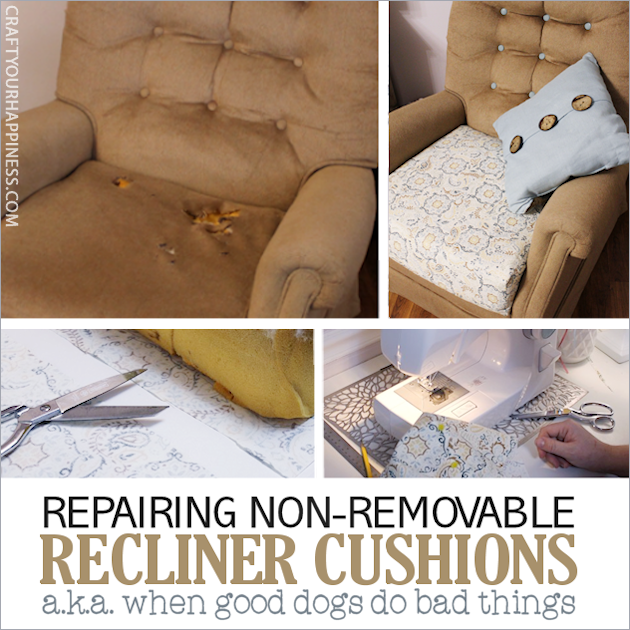To fix a recliner couch, you need to identify the problem and then follow the appropriate troubleshooting steps or seek professional assistance if needed.

Credit: www.reddit.com
Table of Contents
Inspecting The Recliner Couch
In order to fix a recliner couch, the first step is to inspect the recliner couch thoroughly. This involves checking for loose parts and examining the reclining mechanism. A proper inspection will help identify the specific areas that require attention and repair.
Check For Loose Parts
Loose parts can often be the cause of malfunction in a recliner couch. To check for loose parts, carefully inspect the entire structure of the couch, including the frame, joints, and screws. Make sure that all the components are securely fastened and tighten any loose bolts or screws.
Examine The Reclining Mechanism
The reclining mechanism is a critical component of the recliner couch. It is essential to examine this mechanism thoroughly to ensure that it is functioning properly. Test the reclining lever or handle to see if it operates smoothly without any resistance. Inspect the springs, cables, and any other moving parts to identify any signs of wear or damage.

Credit: craftyourhappiness.com
Identifying The Issue
Identifying the Issue:
Determining The Type Of Damage
Firstly, visually inspect the recliner couch for any visible signs of damage such as tears, loose stitching, or broken parts.
Testing The Recliner’s Functionality
Check if the recliner moves smoothly along its track and locks into place at different angles. Ensure that the footrest mechanism is functioning correctly.
Gathering Necessary Tools And Materials
Before you start fixing your recliner couch, it’s important to gather all the necessary tools and materials. Having everything you need on hand will save you time and make the process smoother. Here are the tools and materials you’ll need:
Tools Required:
- Screwdriver: A screwdriver with multiple heads will help you remove screws of different sizes.
- Pliers: Pliers will come in handy when you need to grip and manipulate small parts.
- Allen wrench: Depending on your recliner couch, you might need an Allen wrench to loosen or tighten specific screws.
- Hammer: A small hammer can be useful for tapping and adjusting certain components.
- Staple gun: If your couch requires reupholstery, a staple gun will be necessary for attaching new fabric.
- Scissors: You’ll need scissors for cutting fabric, thread, or any other materials.
- Tape measure: A tape measure will help you take accurate measurements, especially if you’re replacing any parts.
- Flashlight: A flashlight will come in handy to illuminate hard-to-reach areas, making it easier to see what you’re doing.
Materials Needed:
- Replacement parts: Depending on the issue with your recliner couch, you might need to purchase specific replacement parts such as springs, screws, or fabric.
- Cleaning solution: If your couch needs a deep clean, a suitable cleaning solution or upholstery cleaner will be necessary.
- Upholstery fabric or leather: In case you need to reupholster your recliner couch, make sure you have enough fabric or leather for the job.
- Thread and needles: If you’re planning to sew or make repairs to the upholstery, you’ll need thread and needles.
- Foam or padding: If the seat or back cushions of your recliner couch are sagging, foam or padding can help restore their shape.
- Adhesive: Depending on the specific repair, you might need adhesive or glue to secure certain components.
By gathering all the necessary tools and materials, you’ll be well-prepared to dive into fixing your recliner couch. Having everything at hand will help you save time and complete the task more efficiently.
Repairing Minor Damage
If your recliner couch has loose screws, grab a screwdriver and tighten them. Check all visible screws to ensure they are secure.
Locate the tension springs beneath the recliner seat. With pliers, adjust the tension by turning the spring nut clockwise or counterclockwise.
Addressing Major Repairs
If your recliner couch requires major repairs, such as replacing broken parts or repairing the frame, addressing these issues promptly can prolong the lifespan of your furniture. Major repairs may seem daunting, but with the right guidance, you can restore your recliner to its former glory.
Replacing Broken Parts
When it comes to broken parts on your recliner couch, identifying the specific component that needs replacement is crucial. You can purchase replacement parts from the manufacturer or specialized stores, ensuring they are compatible with your model.
Repairing Or Replacing The Frame
If the frame of your recliner couch is damaged, assess the extent of the issue before deciding whether to repair or replace it. Repairing the frame may involve reinforcing weak joints or welding metal parts, while replacing the frame entirely can provide a long-term solution.

Credit: m.youtube.com
Reupholstering The Couch
Reupholstering a couch can give your recliner couch a completely new look and extend its lifespan. Whether your couch is worn out, stained, or simply in need of a refresh, reupholstering can transform it into a stylish and comfortable piece of furniture once again.
Selecting Suitable Fabric
When it comes to reupholstering your recliner couch, choosing the right fabric is crucial for achieving a professional and durable finish. Select a fabric that complements the style of your living space and is also durable enough to withstand everyday use. Look for fabrics that are stain-resistant and easy to clean, especially if you have children or pets.
Additionally, consider the color, pattern, and texture of the fabric to ensure it harmonizes with the overall aesthetic of your home. Natural fabrics like cotton, linen, or leather can provide a timeless and elegant appeal, while synthetic blends like microfiber and polyester are known for their durability and low maintenance.
Step-by-step Reupholstering Process
Once you have selected the suitable fabric, you can begin the step-by-step process of reupholstering your recliner couch. Here is an overview of the basic steps involved:
- Prepare the couch by removing the old fabric, foam, and any staples or tacks.
- Inspect the frame for any damage or necessary repairs before proceeding.
- Measure and cut the new fabric according to the dimensions of each section of the couch.
- Secure the new fabric to the frame using a staple gun or upholstery tacks, ensuring a smooth and tight fit.
- Attach the new foam or padding to provide comfort and support.
- Finish the edges with decorative trims or piping for a polished look.
Ensuring Proper Functionality
When it comes to fixing a recliner couch, ensuring proper functionality is essential for a comfortable and enjoyable seating experience. From testing the reclining mechanism to checking stability and comfort, it’s important to address all aspects of the couch to make sure it functions as intended.
Testing The Reclining Mechanism
Start by inspecting the reclining mechanism of the couch. Ensure that the lever or button operates smoothly without any hesitations or obstructions. Test the various reclining positions to make sure they engage and release properly.
Checking Stability And Comfort
Next, evaluate the stability and comfort of the recliner. If the couch feels wobbly or uneven, it may indicate loose or damaged components. Check the frame, springs, and joints for any signs of wear or damage. Additionally, assess the padding and upholstery for any sagging or tears that could affect comfort.
Maintenance And Care Tips
Maintaining and caring for your recliner couch is important to ensure its longevity and optimal performance. By following some simple maintenance and care tips, you can keep your recliner couch in excellent condition for years to come. In this section, we will discuss two essential aspects of maintenance and care: regular inspection and cleaning, and proper handling and usage.
Regular Inspection And Cleaning
Regular inspection and cleaning are crucial to keep your recliner couch looking and functioning its best. Here are some key points to remember:
- Inspect your recliner couch at least once every few months to identify any issues or signs of wear and tear.
- Check for loose screws, screws that need tightening, or any damaged or broken parts that require repair or replacement.
- Remove any crumbs, dust, or debris from the surface of the couch by using a soft brush or vacuum cleaner. Pay attention to the crevices and folds where dirt can accumulate.
- For leather recliner couches, use a mild leather cleaner and conditioner to keep the leather supple and prevent it from drying out or cracking.
- Fabric recliner couches can be spot-cleaned with a gentle fabric cleaner or a mixture of mild detergent and water. Always test the cleaner on a hidden area first to ensure it doesn’t discolor or damage the fabric.
By performing regular inspections and cleaning, you can catch any minor issues early on and prevent them from turning into major problems.
Proper Handling And Usage
Proper handling and usage of your recliner couch are essential to avoid unnecessary damages and ensure its longevity. Consider the following tips:
- Avoid sitting on the recliner with sharp objects such as keys or tools that can puncture or scratch the surface.
- Do not overload the recliner with excessive weight or put strain on the mechanisms by sitting on the armrests or footrests.
- Refrain from jumping or standing on the recliner, as this can cause structural damage and affect its overall stability.
- If your recliner has a motorized mechanism, make sure to follow the manufacturer’s instructions for proper usage and avoid overusing the motor.
- Adjust the reclining position gradually and avoid using excessive force, especially when reclining or returning the couch to an upright position.
Following these guidelines will help prolong the life of your recliner couch and ensure that it continues to provide utmost comfort and support.
Frequently Asked Questions
Can Recliner Mechanism Be Repaired?
Yes, recliner mechanisms can be repaired. Professional technicians can fix issues with the reclining mechanisms to restore functionality. Maintenance and timely repairs can help extend the lifespan of a recliner.
What Is The Most Common Problem With Recliners?
The most common problem with recliners is their mechanism malfunctioning, including issues with the footrest, backrest, or lever. These problems can occur due to wear and tear over time, leading to a lack of support or difficulty in adjusting positions.
Regular maintenance can help prevent such issues.
Can A Recliner Sofa Be Recovered?
Yes, a recliner sofa can be recovered. You can choose to replace the upholstery with a new fabric or leather cover. Professional services are available for this task to ensure a high-quality and durable result.
What To Do When Recliner Stops Working?
If your recliner stops working, check the power source, cables, and remote batteries. Look for any visible damage, and contact the manufacturer for further assistance.
Read Next:
Conclusion
Fixing a recliner couch doesn’t have to be a daunting task. By following the step-by-step guide provided in this blog post, you can easily diagnose and address common issues such as loose screws, broken springs, or worn-out upholstery. Whether you choose to tackle the repair yourself or seek professional help, taking action will ensure that you can continue to enjoy the comfort and convenience of your beloved recliner couch for years to come.
